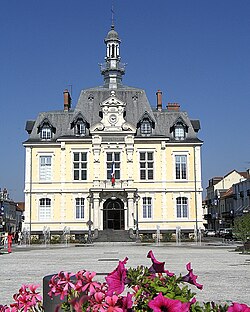Commentry
 From Wikipedia - Reading time: 11 min
From Wikipedia - Reading time: 11 min
You can help expand this article with text translated from the corresponding article in French. (December 2008) Click [show] for important translation instructions.
|
Commentry | |
|---|---|
 Town hall | |
| Coordinates: 46°17′23″N 2°44′32″E / 46.2897°N 2.7422°E | |
| Country | France |
| Region | Auvergne-Rhône-Alpes |
| Department | Allier |
| Arrondissement | Montluçon |
| Canton | Commentry |
| Intercommunality | Commentry Montmarault Néris Communauté |
| Government | |
| • Mayor (2020–2026) | Sylvain Bourdier[1] |
Area 1 | 20.96 km2 (8.09 sq mi) |
| Population (2022)[2] | 6,018 |
| • Density | 290/km2 (740/sq mi) |
| Time zone | UTC+01:00 (CET) |
| • Summer (DST) | UTC+02:00 (CEST) |
| INSEE/Postal code | 03082 /03600 |
| Elevation | 332–462 m (1,089–1,516 ft) (avg. 385 m or 1,263 ft) |
| 1 French Land Register data, which excludes lakes, ponds, glaciers > 1 km2 (0.386 sq mi or 247 acres) and river estuaries. | |
Commentry (French pronunciation: [kɔmɑ̃tʁi]; Auvergnat: Comentriac) is a commune in the department of Allier in central France. It lies 42 miles (68 km) southwest of Moulins in the valley of the Œil. It is within 8 km of one of the geographic centres of France. The film actress Yvonne Rozille (1900–1985) was born in Commentry.
Population
[edit]
|
| |||||||||||||||||||||||||||||||||||||||||||||||||||||||||||||||||||||||||||||||||||||||||||||||||||||||||||||||||||||
| Source: EHESS[3] and INSEE (1968-2017)[4] | ||||||||||||||||||||||||||||||||||||||||||||||||||||||||||||||||||||||||||||||||||||||||||||||||||||||||||||||||||||||
History
[edit]Commentry was home to Compagnie de Commentry-Fourchambault-Decazeville, thanks to an important coal deposit. The coal mine fueled a huge growth in population, from under 1,000 to more than 12,000, while Stéphane Mony was its CEO (1840–1884).[5] Commentry was the first commune ever to elect a socialist mayor: Christophe Thivrier was elected 6 June 1882.[6]
During the repression of January and February 1894, the police conducted raids targeting the anarchists living there, without much success.[7][8][9]
The Socialist Party of France was founded in Commentry in September 1902.
Economy
[edit]Commentry gave its name to a coal field over 21 square kilometres in extent, and historically had important foundries and forges.[10]
Science
[edit]Charles Brongniart discovered many fossils near Commentry, including Meganeura in the Stephanian stage coal measures in 1880.
Personalities
[edit]- Jean Bayet (1882–1969) Professor of Latin Language and Literature at the Sorbonne, whose grandfather Gilbert Bayet was mayor of Commentry 1871–1873.
- Henri Fayol (1841–1925) mining engineer, developed Fayolism, an approach to management and administration.
- Abel Gance (1889–1981) film director and producer, raised by maternal grandparents in Commentry until the age of eight.
- Jacques Hillairet (1886-1984) historian specializing in the history of Paris, officer of the Legion of Honour.
- Émile Mâle (1862–1954) art historian and member of the Académie française.
- Stéphane Mony (1800–1884) Engineer, director of the colliery at Commentry; mayor from 1854 to 1883; deputy from 1868 to 1871.
- Christophe Thivrier (1841–1895) first elected Socialist mayor in France.
- Roger Vergé (1930–2015) Celebrated chef and restaurateur.
See also
[edit]References
[edit]- ^ "Répertoire national des élus: les maires" (in French). data.gouv.fr, Plateforme ouverte des données publiques françaises. 13 September 2022.
- ^ "Populations de référence 2022" (in French). The National Institute of Statistics and Economic Studies. 19 December 2024.
- ^ Des villages de Cassini aux communes d'aujourd'hui: Commune data sheet Commentry, EHESS (in French).
- ^ Population en historique depuis 1968, INSEE
- ^ (in French) L'Administration industrielle et générale par Henri Fayol ISBN 978-2-903628-09-3 https://f-origin.hypotheses.org/wp-content/blogs.dir/1931/files/2016/09/Fayol-1916.pdfArchived 2019-02-07 at the Wayback Machine
- ^ (in French) Election of the first socialist mayor Archived 2016-03-03 at the Wayback Machine
- ^ "Les anarchistes" [The anarchists]. La Dépêche. 3 January 1894. p. 2.
- ^ "Deux mille perquisitions". L'Estafette: 2. 2 January 1894.
- ^ "Une série générale de perquisitions : résultat négatif des recherches" [A general series of raids: negative results]. L'Éclair. 3 January 1894.
- ^ One or more of the preceding sentences incorporates text from a publication now in the public domain: Chisholm, Hugh, ed. (1911). "Commentry". Encyclopædia Britannica. Vol. 6 (11th ed.). Cambridge University Press. p. 766.
 KSF
KSF


